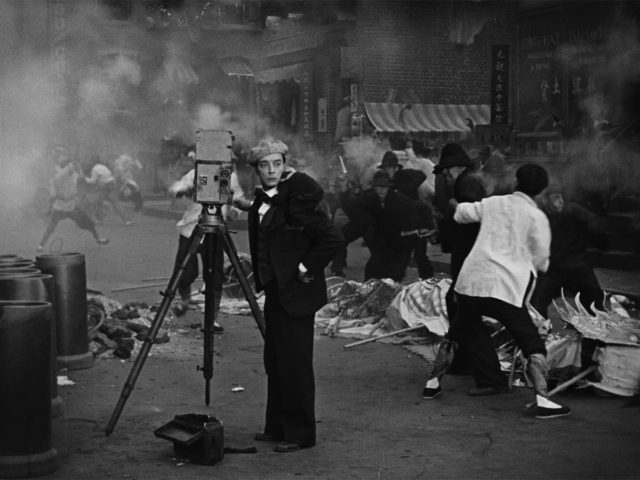
On April 23, 1917, Buster Keaton made his theatrical debut in Roscoe “Fatty” Arbuckle’s The Butcher Boy. Three years later, Keaton would strike out on his own, producing one comic short after the other. Three years after that, Keaton made the leap to feature films under his own independent production company. All are comedic works of art, arguably some of the best movies ever made.
But in the 1920s, they failed to generate money. Keaton’s budgets were enormous, and the movies could not recoup costs. In 1927’s The General — considered by many to be his greatest work (featured here) — Keaton drove a locomotive over a collapsing bridge for the movie’s climax. Producer Joseph Schenck pleaded with Keaton to get costs down so they could make some money. Keaton relented, and his next film, Steamboat Bill, Jr. started as a cut-and-dried story of family miscommunication. The Schenck-approved budget came in at $200,000, but then Keaton got an idea: Stage a cyclone for the movie’s third act. Airplanes were brought in to provide wind, houses were collapsed en masse, and Keaton was knocked about in one spectacular storm. It’s unparalleled, but it also cost another $200,000. When Steamboat Bill, Jr. was released in May 1928, it made squat.
Schenck had enough. He sold Keaton and the company to his brother Nicholas Schenck, an executive at MGM, for the princely sum of $3,000 a week (roughly $44,000 in today’s money). Keaton, who was as frugal with his own money as he was with his budgets, took the offer but later claimed, “It was the worst mistake of my life.”
MGM was The Tiffany Studio, full of glitz and glam, and “more stars than there are in heaven.” It was also the studio where comedy went to die. MGM handcuffed Keaton with insipid plots and weak scripts, restricted his ability to do his own stunts and paired him with comedic foils that went together like peanut butter and sardines. And Keaton was slipping down the bottle, further dulling his ability to keep up. In 1933, MGM cut Keaton loose. It took only four years to bankrupt the Great Stone Face.
In between the peak and the fall came 1928’s The Cameraman, Keaton’s first film for MGM and the last one where he had any control. Keaton plays Buster, a small-time photographer who falls for Sally (Marceline Day), a secretary at a newsroom. Smitten, Buster pawns his tintype camera for a newsreel version and hits the streets looking for a story. If he lands the gig at the newsroom, he’ll also land Sally as his belle.
In typical Keaton fashion, Buster fails until he suddenly succeeds. Equally typical, everyone laughs in his face except for the girl. But Keaton keeps on keeping on, and each of his set pieces — from a baseball game in Yankee Stadium with Keaton playing all the parts, to a partnership with Josephine, a capuchin monkey — The Cameraman is a wonder of Rube Goldberg set-up and execution.
When Keaton fell from grace in the early 1930s, so too did his movies. Cheap, scratchy prints circulated, scenes got cut out or mistakenly lost, and many of the original negatives were destroyed in a fire. Rescuing and restoring these films — often cobbled together from multiple elements — requires Herculean efforts.
Thankfully, The Criterion Collection partnered with the Cineteca di Bologna and Warner Brothers to bring The Cameraman back to its full glory. Criterion’s 4K restoration practically sparkles. The Blu-ray includes Keaton’s second MGM feature, Spite Marriage, three documentaries and an illustrative essay from Imogen Sara Smith — one of the best Keaton scribes in the business.
In a year where home viewing has become the only option for moviegoing, Criterion continues to raise the bar and rescue classic after classic from the dustbin.
ON THE BILL: The Cameraman is available on Blu-ray and DVD from The Criterion Collection.














